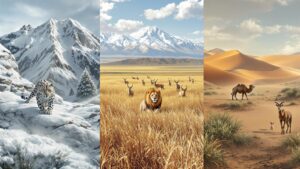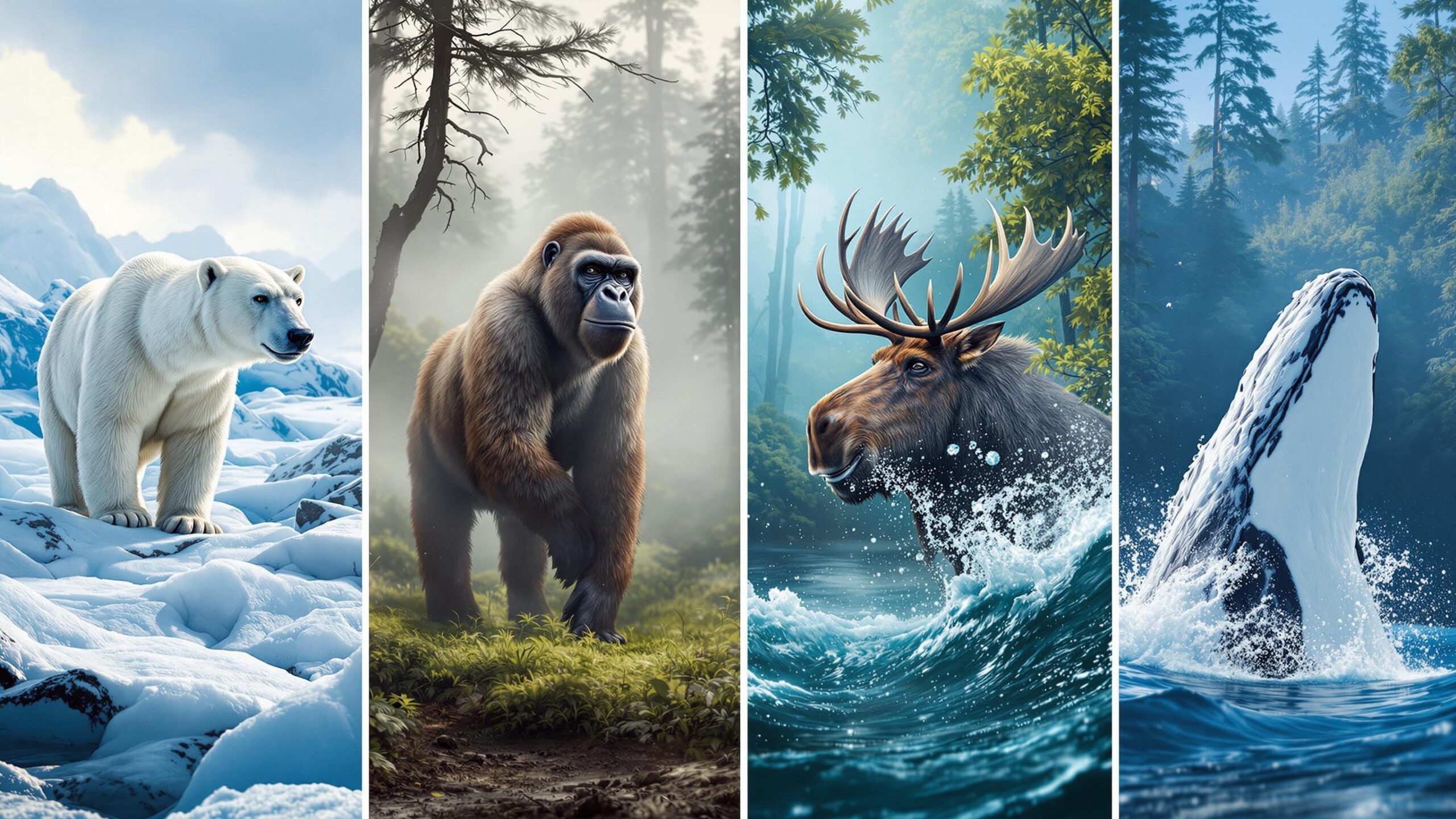Mammals: Nature’s Most Adaptable and Diverse Animal Class
Mammals are among the most fascinating and adaptable creatures on Earth. From the thundering footsteps of elephants to the delicate flutter of a bat’s wings, mammals have evolved to thrive in almost every corner of the planet. They are warm-blooded, have backbones, breathe air through lungs, and almost all of them give birth to live young, feeding their babies with milk from specialized mammary glands—one of their defining characteristics. This class of animals includes a stunning array of shapes, sizes, behaviors, and ecological roles. Whether it’s the comforting purr of a domestic cat or the mesmerizing breach of a whale from ocean depths, mammals offer a gateway into the richness of life on Earth.
What makes mammals truly special is their incredible versatility. Some are built for land, others for the sea, and a rare few have even taken to the skies. This adaptability has made them dominant in many ecosystems, from dense rainforests and vast savannahs to icy polar regions and even urban environments. This page explores five essential categories of mammals—land mammals, marine mammals, flying mammals, domesticated mammals, and rodents & small mammals. Each category tells a different chapter in the story of evolution, resilience, and the interconnection of life.

Land Mammals
Land Mammals: The Dynamic Giants, Sprinters, Foragers, and Architects of Earth’s Wild Landscapes From the dense canopy of tropical rainforests to the sun-scorched deserts and the icy tundras of the far north, land mammals rule the terrain with stunning diversity and adaptation. They are nature’s travelers, architects, hunters, and caretakers of ecosystems—some lumbering and majestic, others small, swift, and stealthy. Land mammals have walked the Earth for tens of millions
Land Mammals: Masters of the Terrestrial World
Land mammals are perhaps the most immediately recognizable of all mammals. They inhabit deserts, forests, mountains, plains, and tundras. These mammals are diverse in both size and function, ranging from the towering giraffe to the burrowing mole. They rely on limbs for mobility—walking, running, hopping, or climbing—and often have specialized adaptations to suit their environments.
The African elephant, for example, is the largest land mammal, equipped with a powerful trunk used for communication, lifting objects, and even drinking. Their intelligence, emotional depth, and family bonds are awe-inspiring. On the opposite end of the spectrum lies the meerkat, a small, social mammal that thrives in arid regions and uses its strong claws for digging and its sharp eyesight for spotting predators.
Carnivorous land mammals such as lions, tigers, and wolves dominate the food chain in many regions, while herbivores like deer, bison, and antelope form the crucial base of land-based food webs. Then there are omnivores—bears and raccoons being notable examples—who play diverse roles in their ecosystems. Humans themselves, the most globally dominant species, are land mammals with an unmatched ability to shape and transform the environment.
Land mammals also demonstrate an incredible range of social structures, from solitary creatures like leopards to highly social species like baboons. This variability showcases the mammalian advantage of adaptability—not just physically but socially and behaviorally. They navigate challenges such as predation, climate extremes, and food scarcity through cooperation, memory, and problem-solving skills.
Marine Mammals: Champions of the Aquatic Frontier
Marine mammals are some of the most majestic and mysterious animals on Earth. These include whales, dolphins, seals, sea lions, walruses, and manatees. Despite living in water, marine mammals evolved from land-dwelling ancestors and still retain essential mammalian features: they breathe air, maintain a constant body temperature, and nurse their young.
The blue whale, the largest animal to have ever lived, is a living titan that glides through the ocean with unmatched grace. Dolphins, known for their intelligence and playful nature, use echolocation to navigate and hunt. Seals and sea lions are masters of both land and sea, hauling out on rocks to rest while diving deep underwater for food.
Marine mammals have developed unique adaptations for life in water. Their bodies are streamlined for efficient swimming, their lungs and oxygen storage systems allow deep dives, and thick layers of blubber insulate them from frigid ocean temperatures. Some species, like orcas, exhibit complex social behaviors, traveling in pods and using distinct vocalizations that could be considered dialects.
The relationship between marine mammals and humans is complex. On one hand, whales and dolphins have inspired legends, art, and conservation efforts. On the other hand, threats like entanglement in fishing gear, ship strikes, noise pollution, and climate change endanger many marine mammal species. Protecting these animals is crucial, not just for their survival but for the health of marine ecosystems as a whole.
Flying Mammals: The Sky’s Only Fur-Clad Navigators
Flying mammals are a rare and enchanting group, with bats being the only mammals truly capable of sustained flight. They comprise about 20% of all mammal species and are incredibly diverse, ranging from the tiny bumblebee bat—one of the world’s smallest mammals—to the large fruit bats known as flying foxes.
Bats are ecological superheroes. They pollinate plants, disperse seeds, and devour insects in massive quantities. Their wings are modified hands, with skin stretched over elongated fingers, allowing for agile and precise flight. Some species can even hover like hummingbirds, while others glide long distances with minimal effort.
Not all bats feed on insects; many consume nectar, fruit, or even small animals. The infamous vampire bats feed on blood but are relatively rare and pose little threat to humans. What unites these creatures is their nocturnal lifestyle and extraordinary use of echolocation. By emitting high-frequency sounds and interpreting the returning echoes, bats can hunt and navigate in complete darkness.
Bats are often misunderstood and unfairly associated with disease and fear. In truth, they are essential to ecosystem health and biodiversity. Their unique ability to fly, combined with mammalian traits such as fur, live birth, and nursing, make them one of evolution’s most fascinating experiments. Flying mammals also challenge our ideas of what mammals can be, pushing the boundaries of form and function.
Domesticated Mammals: Partners in Human Progress
Domesticated mammals have walked alongside humans for thousands of years, shaping civilization as much as they’ve been shaped by it. From transportation and agriculture to companionship and protection, these mammals have embedded themselves into our daily lives and cultural identities.
Dogs, often called “man’s best friend,” have evolved into hundreds of breeds with distinct personalities, abilities, and appearances. Their loyalty, intelligence, and trainability make them ideal working animals as well as cherished pets. Cats, with their mysterious and independent nature, are beloved for their companionship and pest control capabilities.
Larger domesticated mammals like horses, cows, sheep, goats, pigs, and camels have transformed human societies. Horses revolutionized travel and warfare. Cows and goats provide milk, while pigs and sheep offer meat and wool. These animals have been selectively bred for generations to enhance traits useful to humans.
But domestication is more than utility. It represents a deep symbiosis, where both humans and animals benefit. In return for food, shelter, and protection, these animals offer labor, resources, and emotional support. Studies even show that pet ownership can improve human health by reducing stress and promoting exercise.
Domesticated mammals reveal much about humanity itself—our need for connection, our capacity to nurture, and our ability to shape the natural world. They serve as living bridges between nature and culture, instinct and civilization.
Rodents and Small Mammals: The Hidden Engines of Ecosystems
Rodents and small mammals might not have the grandeur of elephants or the charisma of dolphins, but they are some of the most crucial players in Earth’s ecosystems. This category includes mice, rats, squirrels, beavers, shrews, moles, and rabbits, among others. Despite their size, they are abundant, versatile, and often overlooked champions of biodiversity.
Rodents make up the largest order of mammals. Their signature feature is a set of ever-growing incisors, which they use for gnawing wood, seeds, and vegetation. Beavers, for instance, are natural engineers that create wetlands by damming rivers—ecosystems that support countless other species. Prairie dogs aerate the soil and provide shelter for other animals with their burrow systems.
Small mammals are often prey for larger predators and thus form a crucial link in the food web. Their rapid reproductive cycles and adaptability make them resilient, even in changing environments. Some, like lemmings, are famous for population booms and busts, which influence predator numbers and ecosystem dynamics.
These creatures are also scientific heroes . Laboratory mice and rats have contributed to medical breakthroughs that benefit all mammals, including humans. Despite being labeled as pests in some settings, many small mammals are ecological linchpins, controlling insect populations, distributing seeds, and influencing plant growth.
Rodents and small mammals remind us that size isn’t everything in nature. Their industriousness, adaptability, and ecological value prove that even the smallest players can have the biggest impact.
Mammals as Mirrors of Evolutionary Wonder
Mammals are more than a biological classification—they are a living gallery of evolution’s possibilities. From land to sea to sky, mammals exhibit an extraordinary range of adaptations, behaviors, and relationships with one another and with humans. They are storytellers of survival, intimacy, intelligence, and interdependence.
Their fur-covered bodies, nurturing behaviors, and dynamic movements captivate the imagination. Whether in the quiet of a forest, the depths of the ocean, or the comfort of a family home, mammals offer daily reminders of life’s richness. They connect us to the wild, to history, and to the deep biological truths that bind all living things.
As stewards of the planet, it’s our responsibility to understand and protect mammals in all their forms. Whether we marvel at the mighty whale, care for a loyal pet, or study the humble field mouse, we’re engaging with creatures that share more with us than we might realize. In every heartbeat and breath, mammals reflect the resilience and wonder of life itself. They are nature’s greatest testament to survival through adaptation—and our closest companions on this shared journey around the sun.

